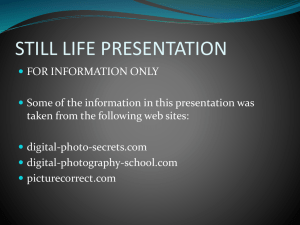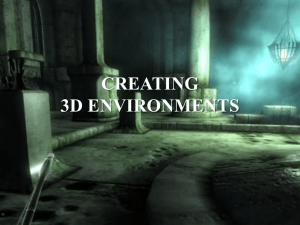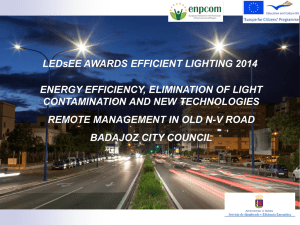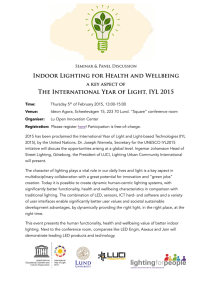Lighting
advertisement
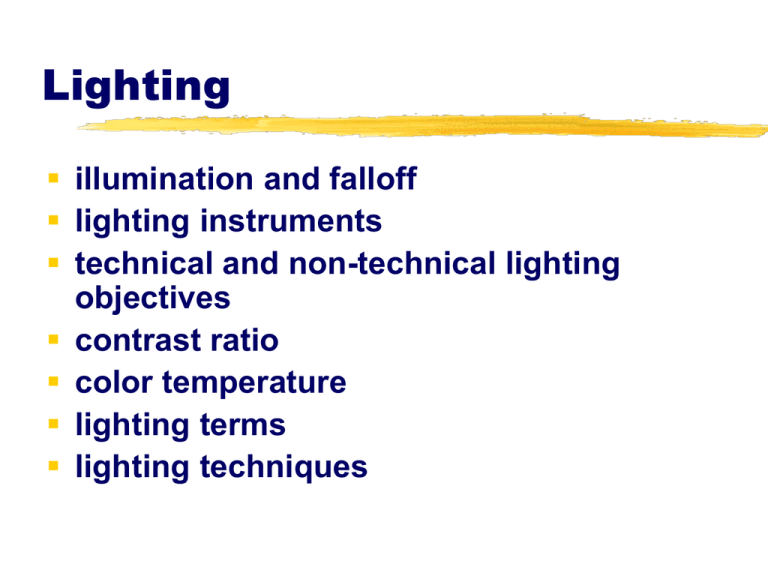
Lighting illumination and falloff lighting instruments technical and non-technical lighting objectives contrast ratio color temperature lighting terms lighting techniques Falloff the speed (degree) with which a light picture portion turns into shadow areas Fast Falloff fast falloff means that the light areas turn abruptly into shadow areas and there is a great brightness difference between light and shadow areas Slow Falloff slow falloff indicates a very gradual change from light to dark and a minimal brightness difference between light and shadow areas Fast Falloff Slow Falloff Fast Falloff Slow Falloff No Falloff Directional and Diffused Illumination Directional Illumination illuminates a relatively small area with a distinct light beam produces well defined shadows and causes fast falloff use spotlights which emit a directional light beam Directional and Diffused Illumination Diffused Illumination illuminates a relatively large area with a wide indistinct light beam produces soft, rather undefined shadows and slow falloff use floodlights which emit a diffused light beam Spotlights and Floodlights Fresnel Spotlight Scoop Floodlight Lighting Instruments Fresnel lens Aperture and shutters “Kookie” pattern holder Focusing spindle Lens system Ellipsoidal reflector Diffused light Scoop reflector Fresnel Spotlight Beam Control Spot - Directional Illumination Fresnel Spotlight Beam Control Flood - Diffused Illumination Fresnel Spotlight Beam Control Barn Doors Scoop Floodlight W-6 Mic W-5 2 3 4 W-5 2 3 2 4 3 2 3 4 4 2 2 3 3 4 4 W-3 Mic 1 1 1 1 1 1 Mic 1 1 1 1 1 1 Control Room B-2 B-1 B-4 B-3 B-6 B-5 B-8 B-7 B-10 B-9 B-12 B-11 W-8 2 2 2 2 2 2 3 3 3 3 3 3 W-4 4 4 4 4 4 4 W-1 W-2 Technical Lighting Objectives to provide enough light (baselight) for the camera to limit the contrast ratio to provide the proper color temperature Contrast Ratio Hi : Lo Lux 6000 : 100 fc 60 : 1 The difference between the brightest and the darkest spots in the picture (measured by reflected light in footcandles). Contrast Ratio should be no more than 40:1 Color Temperature Color Temperature Low High Portable Light Kelvin Scale Portable lights =3200°K 1000° 3200° portable light 4000° 5600° >7000° Studio Light Kelvin Scale Studio lights =3200°K 1000° 3200° portable light studio light 4000° 5600° >7000° Fluorescent Light Kelvin Scale Fluorescent lights =4000°K 1000° 3200° 4000° 5600° portable light studio light fluorescent tube >7000° Outdoor Rated Light Kelvin Scale 1000° 3200° portable light studio light Outdoor rated lights=5600°K 4000° 5600° >7000° outdoor rated light fluorescent tube Daylight Kelvin Scale 1000° Daylight >7000°K 3200° portable light studio light Outdoor rated lights=5600°K 4000° 5600° >7000° outdoor rated light fluorescent tube daylight White Balance No White Balance White Balance Scene has bluish tinge Without adjustment White shirt has bluish tinge Blue channel reduced Scene has orange tinge Without adjustment White shirt has orange tinge Red channel reduced White shirt appears white White shirt appears white White Balance for Daylight White Balance for Studio Mixed Light Sources Mixed color temperature Mixed Light Sources Kelvin Scale 1000° 1000° 3200° 3200° 4000° 4000° portable light light portable studio light light studio Mixed color temperature 5600° 5600° >7000° >7000° outdoor rated rated outdoor light light fluorescent tube tube fluorescent daylight daylight Mixed Light Sources Kelvin Scale 1000° 3200° 4000° 5600° >7000° portable light studio light Orange gels lower color temperature daylight Mixed Light Sources Kelvin Scale 1000° 3200° 4000° 5600° >7000° portable light studio light Blue gels raise color temperature daylight Non-technical (Aesthetic) Lighting Objectives to indicate form and dimension to create an illusion of reality or nonreality to indicate mood The Photographic Principle or Basic 3 Point Lighting Key Light principal light source reveals the basic shape of the object or person Key Key Light Back Light Back provides more definition to the actual shape of the subject separates her from the background gives sparkle and highlights to her hair Key Back Light Fill Light Back makes the shadow side more transparent reveals details without erasing the form-revealing shadows altogether Fill Key Fill Light Background or Set Light Back Background or Set illuminates the background or set area must be on the same side of the camera as the key light in order to keep shadows on the same side Fill Key Set Light Lighting Angles and Elevation Key Back Key 30°-45° 35°-40° 45°-55° Back 30°-45° Fill Depends upon height of instrument Depends upon height of instrument Lighting Ratios Back (same as key: 200 fc or 2,200 lux Background (200 fc or 2,200 lux) Fill (100 fc or 1,100 lux) Key (200 fc or 2,200 lux) Camera lighting ratios differ, depending on the specific lighting task or application these ratios are a good starting point ———————————— Key : Back : Fill 1 : 1 : 1/2 Multiple Triangle Application Back 2 Fill 1 Person 2 Person 1 Back 1 Fill 2 or Fill 1 & 2 (optional) Key 2 Key 1 Camera a separate lighting triangle with its own key, back, and fill light is used for each subject (or performance area) you may use floodlights in more than one triangle, but if you have enough instruments, don’t make that compromise Side Light Back light Side (spot, flooded) Side (spot, flooded) Camera strikes the subject from the side it can act as key and/or fill light in this case, two opposing side lights are used as key and fill Side Fill Light Back light Side fill light Fill light Key light gives the key side of the subject basic soft illumination allows the key to provide accent and sparkle use a floodlight Kicker Back light (full intensity) Kicker (full intensity, low-angle position) Fill light Key light rims the subject opposite the key emphasizes contour helps separate the foreground subject from the background Cross-Keying Person 2 Back 2 Person 1 Key 1 Back 1 Key 2 Camera the key light for person 1 also functions as back light for person 2 the back light for person 1 also functions as the key light for person 2 if you have enough instruments, use separate keys and back lights for each subject Large Area Lighting Spots Spots or floods Floods Camera the fresnel spots at the left and right Spots or function as key floods and directional fill light spots are also strung out as regular back lights behind the main action area scoops provide additional fill light from the front High Key Lighting abundance of bright light creates high-energy feeling key light is flooded Dramatic Lighting also known as Rembrandt lighting uses contrast selectively dimly lit with lots of dark screen areas Silhouette Lighting unlighted objects or people in front of background use only diffused background light Horror Lighting key light below eye level shadows fall upward use back light for highlight Lighting Exercise 1 Camera Lighting Exercise 1 Key (spot) Camera Lighting Exercise 1 Back (spot) Key (spot) Camera Lighting Exercise 1 Back (spot) Fill (flood) Camera Key (spot) Lighting Exercise 1 Back (spot) Background (floods) Fill (flood) Camera Key (spot) Lighting Exercise 2 2 1 3 1 2 1 — Interviewer 2 — Guest A 3 — Guest B Lighting Exercise 2 Key 1 (spot) 1 2 1 — Interviewer 2 — Guest A 3 — Guest B Lighting Exercise 2 Back 1 (spot—strong) Key 1 (spot) 1 2 1 — Interviewer 2 — Guest A 3 — Guest B Lighting Exercise 2 Back 1 (spot—strong) Fill 1 (flood) Key 1 (spot) 1 2 1 — Interviewer 2 — Guest A 3 — Guest B Lighting Exercise 2 Back 1 (spot—strong) Key 2 (spot) Key 3 (spot) Fill 1 (flood) Key 1 (spot) 1 2 1 — Interviewer 2 — Guest A 3 — Guest B Lighting Exercise 2 Back 1 (spot—strong) Back 2 (spot—strong) Key 2 (spot) Back 3 (spot—weak) Key 3 (spot) Fill 1 (flood) Key 1 (spot) 1 2 1 — Interviewer 2 — Guest A 3 — Guest B Lighting Exercise 2 Back 1 (spot—strong) Back 2 (spot—strong) Key 2 (spot) Back 3 (spot—weak) Key 3 (spot) Fill 1 (flood) Fills 2 & 3 (floods) Key 1 (spot) 1 2 1 — Interviewer 2 — Guest A 3 — Guest B Lighting Exercise 2 Back 1 (spot—strong) Back 2 (spot—strong) Key 2 (spot) Back 3 (spot—weak) Key 3 (spot) Fill 1 (flood) Fills 2 & 3 (floods) Key 1 (spot) 1 2 1 — Interviewer 2 — Guest A 3 — Guest B Next Week... Quiz 2 Lighting Videotape/Post Production


